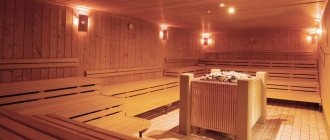The history of the bathhouse
The bathhouse appeared in ancient times; its history dates back to the period of mankind’s exploration of fire. The prototype was a hearth in the middle of a primitive dwelling. When water accidentally splashed onto the hot stones, steam appeared. Ancient man felt the pleasure of moist heat.
According to another version, the history of the steam room begins with natural thermal springs. Ancient people warmed themselves in hot water, enjoying the warm steam and cleanliness of their bodies.
South American Indians steamed in a clay “sweating chamber” - temezcal. They built it near waters for washing and cooling. Something similar exists in modern Guatemala.
Among the ancient aborigines of North America, the steam room was a wigwam with hot stones inside, which were sprayed with water to generate steam.
Important! This method is used today in hiking conditions by geologists and tourists.
The Scythian history of the appearance of a steam room among ancient nomadic tribes is described by Herodotus: they built it from three poles, covered it with skins or felt. The ancient Scythians steamed with ritual dances, inside the tent they threw heated stones and hemp into a cauldron of water, and in the clouds of steam they beat themselves with brooms.
The history of Ancient China and India reveals that the bathhouse appeared in the 12th century BC, when baths of hot water with herbs and fragrant compresses began to be used for hygienic purposes.
Japanese sento is structured according to a different principle and is distinguished by its ancient traditions. She has a very high temperature. The man steamed, alternately plunging into barrels with very hot water, and then with sawdust heated to 60 degrees. After warming up, there was a massage with oils and a tea ceremony.
The history of Ancient Egypt tells about the appearance of steam rooms of complex design: from below, huge stone boulders were heated by fire, from above they were doused with hot water and steam. Visitors to the steam room were given a massage with oil and incense on warm stones.
The bathhouse of Ancient Greece had a similar device. History reveals what place it occupied in the culture of the ancient Greeks. Due to the high cost of heating, it becomes public, completely displacing private ones. The ancient Greeks, having proclaimed the cult of the human body, visited it every other day.
Roman baths were brought to perfection by ancient masters; these are luxurious cultural and entertainment complexes, decorated with marble, sculptures and fountains. In addition to the steam room, it included many rooms and premises of different directions:
- for relaxation and rest;
- massage rooms;
- pools for ablution and swimming with different water temperatures;
- libraries;
- sports grounds;
- interest clubs;
- GYM's.
But the steam rooms themselves were used by the Romans as medical procedures prescribed by a doctor; ordinary visitors used them infrequently.
The advent of central heating of the hypocaust system made it possible to change the temperature and humidity of rooms remote from the firebox. This allowed visitors to get used to the increase in temperature gradually, choosing the most comfortable conditions for themselves.
The history of the hamam comes from the ancient Roman baths. Optimal temperature and high humidity in steam rooms promote profuse sweating. A Turkish hammam has a more beneficial effect on the skin than a Russian bath.
In the harsh Russian climate with extremely low temperatures in winter, it is problematic to heat large rooms. This explains the history of the compactness of the steam room in Rus'.
Attention! The traditional Russian bath, due to its high temperature, is considered a powerful pacemaker.
The ancient Finnish sauna is a traditional bathhouse in Rus'. What we are used to seeing in modern urban life only vaguely resembles a Russian steam room. An electric oven is more economical and safer. It takes up little space and easily maintains a constant temperature, which is why it is installed in apartments.
How they washed in ancient Egypt
Thanks to excavations, it became known about the complex baths in ancient Egypt. There were huge stones on the top floor, and they were heated from the bottom floor. These giants had a hole through which steam came from below.
People lay down on these boulders, and the bathhouse workers rubbed them with ointments and massaged them. Everything was provided here: a swimming pool, a room for gymnastics, even a medical room. The Egyptians were very practical, the bathhouse's spillway was used for central heating of the city.
On ancient papyri and drawings you will not see a complete Egyptian. They were slim and thin, and bath procedures helped them with this. The use of aromatic oils and massage in the bathhouse kept them away from old age.
Such is the rich history of bathing in Ancient Egypt.
Bath in ancient Egypt
Who invented the Russian bathhouse
The history of the Russian bath is one of the most ancient. Its appearance dates back to the birth of the Slavic tribes.
Although the Russian bathhouse is still a collective creation, its roots are connected not only with the ancient Slavs, but also with the Finnish, Ugric peoples and ancient tribes of hunters of the Volga region, the Urals and Siberia.
When did baths appear in Rus'?
The bathhouse appears in the history of the Eastern Slavs in connection with the veneration of ancient pagan gods. There is a description of how a bathhouse was constructed by the Byzantine historian Procopius of Caesarea (early 6th century).
In the “Tale of Bygone Years,” an ancient historical monument from around 1110, the monk chronicler Nestor documents that the bathhouse appeared in Rus' already in the 5th-6th century.
Comment! The history of the appearance of the word “bath” dates back to its mention in the chronicles of the 11th century, before that it was called mylnya, vlaznya or movnitsa.
There is historical information that tribute was taken from conquered tribes with birch brooms.
For what purpose was the bathhouse invented?
For ancient pagan beliefs, the bath is associated with overcoming evil, worshiping the elements of fire and water, and only then with cleansing the body. All stages of the life of the ancient Slavs are closely intertwined with ritual ablutions.
Ancient Greek doctors discovered how the bathhouse has a beneficial effect on human health. The monks of the Kiev Pechersk Lavra confirmed the healing effect of hot steam. Already in the 10th century, the first healing “institutions for the infirm” began to appear - a bathhouse with a hospital for the sick and suffering. The Russian steam room brings relief from joint diseases, radiculitis, coughs, colds and skin diseases.
Known in history, Dobrodeya - the granddaughter of the Russian prince Vladimir Monomakh - was famous for her knowledge of healing with drugs from medicinal herbs. She emphasized the importance of cleansing the body and recognized how beneficial the Russian bath is, without which “I wouldn’t be healthy.”
The Russian bathhouse treated all diseases, not only physical, but also spiritual. The bathing of spouses after the wedding night was considered obligatory. The bathhouse was the place of birth and the first days of life of the baby with the woman in labor. After the funeral or fortieth day, they went to take a steam bath, symbolically washing the deceased before God. The Russian tradition of washing a guest “out of the way” is widely reflected in the history of ancient folk tales.
In villages, almost every family had its own home bathhouse, and in the city public bathhouses became very popular.
Traditional Russian bath
Ancient manuscripts reveal the history of the construction of bathhouses in Rus'. Initially, the Russian bathhouse was a low hut with a small window under the ceiling. All cracks were carefully sealed with moss and resin. Inside the room there was a barrel of water and a fireplace made of stones in the corner. The door was tightly sealed to prevent steam from escaping. When the fire heated the stones, they were sprayed with water. Bundles of branches were waved around the body, increasing the heat around it.
Important! A Russian bathhouse was always built on the shore of a reservoir or near a well, so as not to experience difficulties with water.
Throughout history, the Russian bathhouse has undergone minor changes.
- The place of the hearth was taken by a stove-stove for a third of the hut.
- Wide wooden sunbeds appeared.
- A pipe with a damper was added, but this is an even later invention.
In ancient Rus', the bathhouse was called mylnya or vlaznya. The history of the word is explained by the method of washing: the steam room was located right inside the oven. After cooking, the coals and ash were shoveled aside, the hot stones were lined with straw, on which the steaming person lay. Having gotten used to the heat, he sprinkled water on the roof of the stove and carefully fanned himself with a birch broom.
Later, the Russian bathhouse became a separate building, similar to a smoke hut. Preference was given to places on the banks of rivers, so as not to carry water from afar. This is where the history of the Russian tradition comes from: after a fever, cool down by diving into an ice hole, or dousing yourself with ice water. To avoid fires, the bathhouse was always built at a decent distance from the home.
The Russian bathhouse is heated with hardwood firewood, mainly birch. A boiler was heated on a fire in the room, and smoke was released through a hole in the roof or through a door. Tar and soot settled on the walls of the room, which gave it the name “black.” It was believed that tar disinfected the air. This bathhouse had a bactericidal effect and had a beneficial effect on healing colds and skin diseases.
The history of the appearance of a stove-heater with a chimney and a damper led to the ability to regulate the temperature and humidity inside a steam room, eliminating soot and soot. The Russian bathhouse became clean and “white”.
The steam room began to be equipped with wide sun loungers of different heights. The lower shelf was used for washing, and on the upper lounger under the ceiling, where the temperature rose very high, men steamed. The middle level was occupied by women with children.
Comment! A stone bath appeared in 1090; before that, all buildings were made of wood.
How did you wash then?
In Rus', public bathhouses are gaining popularity under Peter the Great, who himself loved to take a steam bath and contributed to the Russian bathhouse becoming famous abroad.
In large cities, the public “trade” bathhouse was visited by noble merchants and nobility for the sake of relaxation and communication. It became a place where important matters and political issues were decided and news was exchanged.
The Russian bathhouse was heated weekly, and people usually took steam on Saturdays. It is difficult to call such a washing process a complete cleansing; ancient ancestors rarely used soap and used specific products:
- soap root (soapwort);
- ash (lye);
- vinegar.
The Russian tradition of drinking kvass, honey or beer after the steam room took root; they were also sprinkled on the hot stones of the steam room for aroma. And at the end we rested for a long time over a samovar of tea with herbs.
The Russian steam room has always been valued for its influence on the health of the body. In 1733, the first medicinal bathhouse was opened with the permission of the Moscow chancellery with a ban on drinking strong drinks in it.
In Rus', it was customary to take a steam bath at the same time with the whole family and children. Separate public baths appeared only in 1743 by decree of Empress Catherine the Great, prohibiting the joint bathing of men and women, except for children under seven years of age.
European travelers fell in love with the Russian steam room. It was not for nothing that foreign doctors associated the heroic Russian health with the habit of hot steaming and dousing with ice water.
Not all foreigners are able to withstand the heat that a Russian bath gives, so they steam at a lower temperature.
The great Russian commander Alexander Suvorov, a lover of hot steaming, arranged this pleasure for soldiers on military campaigns. In post-Napoleonic times, the Russian bathhouse began to actively spread in the territories liberated by the troops.
Initially, the bathhouse in Rus' consisted of one room where people washed and steamed. Sometimes there was a separate locker room where we rested after the steam room. Over time, the steam room and washing room were separated and began to be equipped with rooms for relaxation, a font or a swimming pool.
Greek laconiums - the center of the cultural life of the Hellenes
In Europe, baths first appeared in Ancient Sparta. They were small round buildings with springs, in the middle of which there was a fireplace. The temperature in the building was high. Classical baths - laconiums - appeared in Greece during the Hellenistic era and were used by all citizens, regardless of status. The founder of the Laconiums was Alexander the Great. In 330, he was on a campaign in Egypt and there he became addicted to bathhouse traditions. Returning to his homeland, the emperor launched a grandiose construction project throughout the country and soon the laconiums became the center of the cultural life of the Greeks.
Roman baths and the birth of parliamentarism
All free citizens of Rome gathered in the ancient Roman baths (therms), which resembled Greek laconiums. Here they had conversations and debates, found a common opinion and then formalized it. Beauty and luxury - this is how travelers described these structures. Historians consider the baths to be the prototype of parliament. They accommodated a huge number of people and were surrounded by gardens with pavilions and fountains. Those who wished could spend time in the library or meeting room. There were also rooms in the building that were reminiscent of today's fitness centers. The complex design of the baths is considered an example of the highest skill of ancient Roman architects. The premises included swimming pools, steam rooms and dry baths, as well as rooms for massage and anointing bodies with oils. The Baths of Carakkala are considered one of the wonders of Rome; this status was assigned to them back in the 5th century.
The Romans, like the ancient Egyptians, considered the bathhouse the primary means for treating and preventing diseases, and in ancient times there were many of them, and very insidious ones. Unfortunately, modern people have forgotten about this. They are ready to swallow packs of chemicals instead of receiving aesthetic and physical pleasure in the bathhouse, not only treating the disease, but also preventing it. A good mood, cleanliness of the body and moderate physical activity, according to Asclepiades, are the key to healthy longevity. Let us remember that this ancient Roman doctor is considered the founder of physiotherapy, psychotherapy and molecular medicine.











